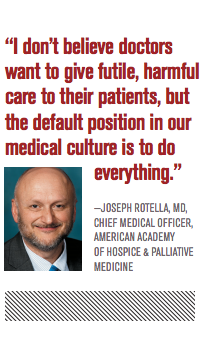Article
Why end-of-life care planning is a necessary service
Author(s):
Physicians must confront these difficult conversations
Do most physicians know what treatments their patients would want if they became seriously or even terminally ill?
Since 2016, physicians have been able to bill Medicare’s Physician Fee Schedule for a visit with a beneficiary to discuss advance care planning and preferences about the patient’s medical care for some future point when the patient’s condition worsens or the person is no longer able to express care preferences.
This care planning conversation might make some patients-and physicians-uncomfortable, but it is voluntary and it offers an opportunity to explore the patient’s values and wishes in a circumstance when no crisis is looming.
“We are quickly moving to a healthcare payment system based on value and outcome,” says Jean Acevedo, a healthcare billing and compliance consultant in Delray Beach, Florida. “Any service that can help patients make personal decisions about their healthcare, based on how much aggressive treatment they are likely to want or not want in those situations, is a good thing.”

Not only that, she says, but Medicare encourages physicians to do an annual wellness visit with their Medicare patients-even sending emails to beneficiaries reminding them of this service. If at that wellness encounter a discussion about advance care planning is initiated, there is no co-pay for the patient, but the physician is able to charge an additional fee for the advance care planning part of the visit.
Advance directives are written legal documents designed to allow patients to guide their medical care at a future time when they can no longer speak for themselves. One type of advance directive, the living will, describes medical treatments a person might want or not want, while the Durable Power of Attorney for Health Care Decisions names a surrogate authorized to speak on the patient’s behalf.
In a number of states, a related document called POLST (Physician Orders for Life-Sustaining Treatment) allows patients and their physicians to spell out more specific treatment choices when the patient’s advancing illness makes them timelier.
In all of these cases, the advance directive document should follow a thoughtful conversation.
The patient’s attending or primary care physician often is best situated to guide such conversations, based on a history with the patient and an understanding of the kinds of medical issues that are likely to shape the patient’s future medical needs.
Those future needs are far from self-evident, but the physician can help the patient understand what is reasonable to expect. While advance directive documents are often associated with a preference to withhold aggressive treatments such as resuscitation, mechanical ventilation or feeding tubes, they can also be used to capture preferences for everything medically appropriate to be done in a crisis.
The legal framework for advance directives varies considerably from state to state, but a number of national groups, including Five Wishes, the Conversation Project, and many health plans, try to make it easier for patients to access sample documents and tools for completing them. Other groups are developing electronic registries to make the patient’s advance directive more easily accessible in a crisis.
Conversation Is Important
“Everyone would agree: these conversations are very important, and for the government to pay for them is a huge step forward,” says Tim Short, MD, a palliative care physician at the University of Virginia Health System in Charlottesville. “But it’s not enough to pay for them; we need to make sure that practitioners know what they’re doing-which may require training.”
Short says these conversations are happening more often these days but they don’t always translate in meaningful ways to impact how care is delivered.
“I live and breathe these conversations every day in my work, so I was surprised to find that we don’t have really good double-blind data on the outcomes and effectiveness of advance care planning.”
The Technical Fine Print
The fee for a doctor’s care planning visit, based on time spent, can run about $85 for an encounter lasting between 16 and 30 minutes. The government doesn’t spell out additional requirements for the visit, Acevedo says.
“Medicare is pretty clear that this is a voluntary discussion for the patient, the documentation should reflect that the patient consented to have the discussion,” she says.
The notes should address who was present and what kinds of treatment decisions were made or advance directive documents discussed. “And, of course, since these are time-based codes, the number of minutes spent in the discussion must be documented,” Acevedo adds. But it is not required that a completed advance directive results from the visit.
The Patient Needs a Say
Advance care planning, done to help prevent the provision of care that would not be wanted by the patient, requires a discussion with that patient, says Joseph Rotella, MD, chief medical officer of the American Academy of Hospice and Palliative Medicine and a physician in Louisville, Kentucky.
“The people we care for want to have a say in their care. Many families have had the experience of a loved one who was on life support, where the family has to make painful decisions. The only thing that can make it easier is if they know what the patient would have wanted,” he says.
“I don’t believe doctors want to give futile, harmful care to their patients, but the default position in our medical culture is to do everything,” Rotella adds. “We all find it challenging to talk about the end of life. But when we lean in and think about it and take some control over our preferences and have these conversations, we realize that we do have choices. It can be empowering.”





